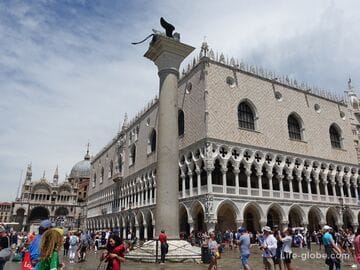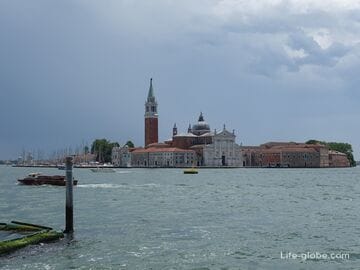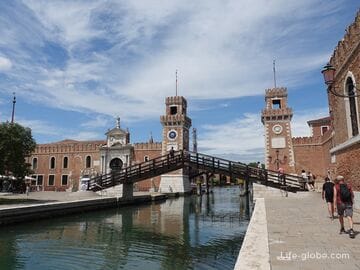San Rocco is the residence of the Abbey of St. Roch (Rocca) in Venice.
Among the people, San Rocco is considered a defender against the plague, and he is, along with St. Mark, the patron saint of Venice.
San Rocco is a complex of ancient buildings consisting of the Scuola (fraternity school) of San Rocco and the Church of San Rocco, now museums.
The complex is located in the historical center of Venice, near the Basilica of Santa Maria Gloriosa dei Frari (Basilica di Santa Maria Gloriosa dei Frari), famous for the majestic monuments of outstanding Venetians, including paintings and as the resting place of Titian, Antonio Canova and a number of doges.
The San Rocco complex, consisting of two historical buildings, visually represents a single architecturally harmonious ensemble.
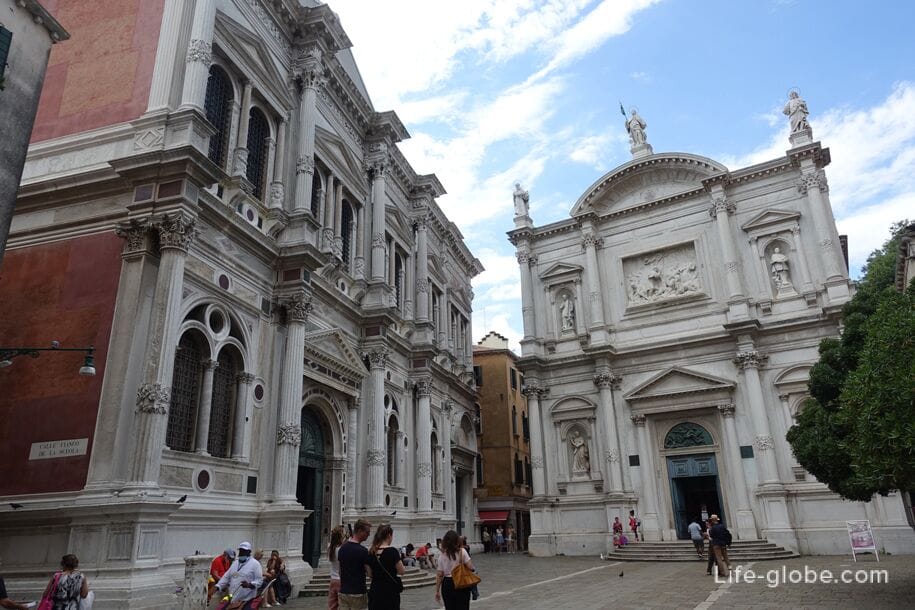
Scuola San Rocco
Scuola Grande di San Rocco (the Great School of Saint Rocco, Scuola Grande di San Rocco) was founded in 1549 as the residence of the Brotherhood of San Rocco (brotherhood of lay people engaged in charity).
The Brotherhood of San Rocco itself was founded in 1478 to provide charitable assistance to the sick. By 1515, the Brotherhood had more than 500 members and a large building was required for it. The construction of the scuola building began according to the project of Bartolomeo Bon, who was replaced by Sante Lombardo, who in turn was replaced by the architect Antonio del Abbondi (known as Scarpagnino), who completed the second floor and the main entrance. After Scarpagnino's death in 1549, the last architect to work on the building was Giangiacomo dei Grigi, who completed the work in September 1560.
The building has two floors and stands out for its beautiful architecture. The floors are characterized by double Venetian windows, pediments and architectural columns with pilasters.
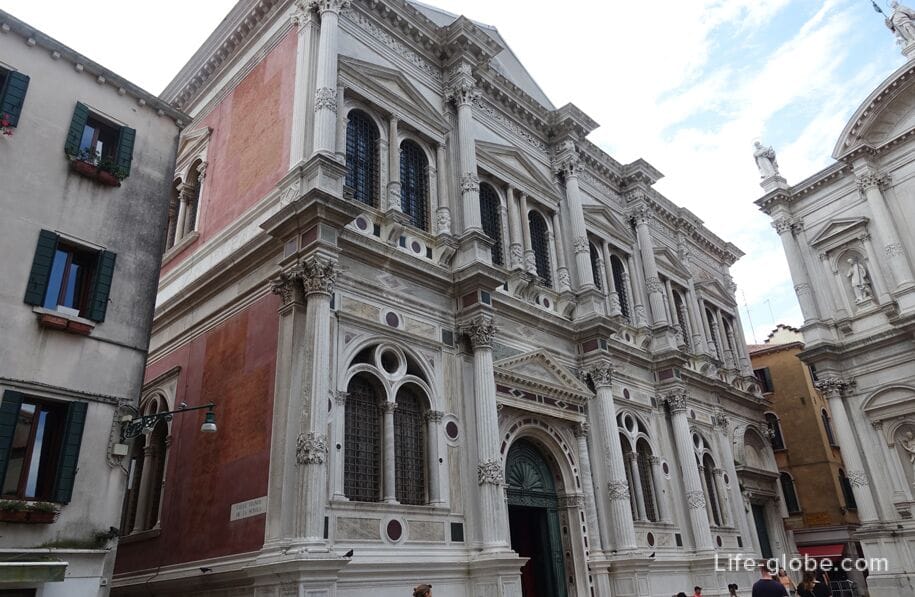
Today, in the building of the scuola, you can visit the monumental staircase and halls decorated with frescoes and paintings telling about the Virgin, the life of Christ, saints, including Saint Rocha, biblical stories, mythology, as well as allegories of the seasons, human virtues and virtues.
In 1564, the famous Italian artist Tintoretto was commissioned to decorate the scuola. He created a wonderful cycle of paintings in the halls of Scuola between 1564 and 1588. These canvases represent to Venice what the Sistine Chapel represents to Rome. Thus, today the Scuola San Rocco is the largest collection of Tintoretto paintings in the world, placed in halls on walls and ceilings. In addition, the collection of Scuola's masterpieces includes works by Titian, Giorgione, Antonio Zanki, Tiepolo, Pietro Negri and Giovanni Antonio Fumiani.
Between 1741 and 1743, the carver Giovanni Marchiori created wooden bas-reliefs depicting the life of Saint Roch. The works adorn the entire perimeter of the presbytery of the Chapter Hall, in particular, they cover the doors of the cabinets of the eighteenth century, in which the books and documents of the scuola were once stored.
On the second floor of the Scuola, in a room built by Giorgio Fossati in 1773, there is the Treasury of the Scuola San Rocco, which is furnished with large cabinets of the eighteenth century, which store items intended for religious worship.
There is also a collection of unique ceramics in the school, and temporary exhibitions are held.
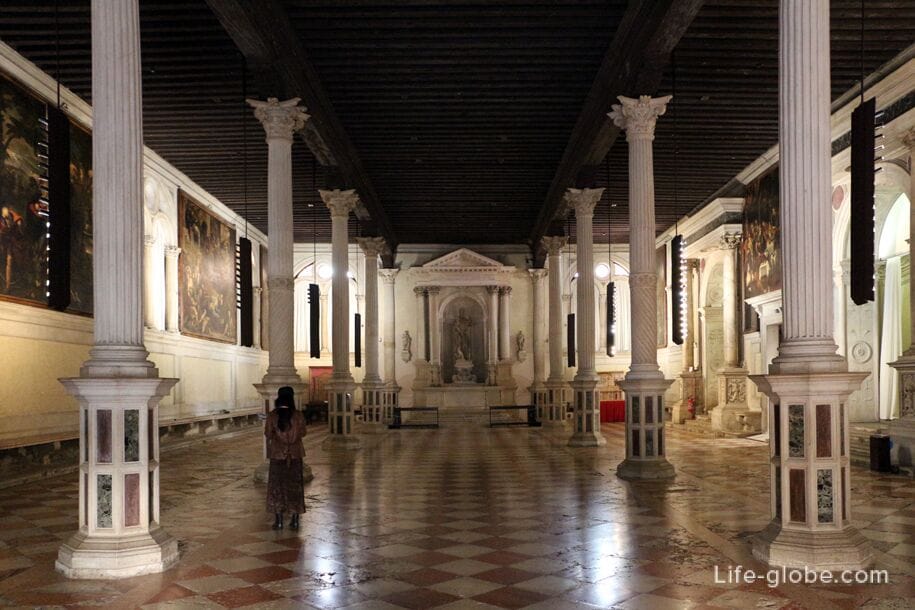
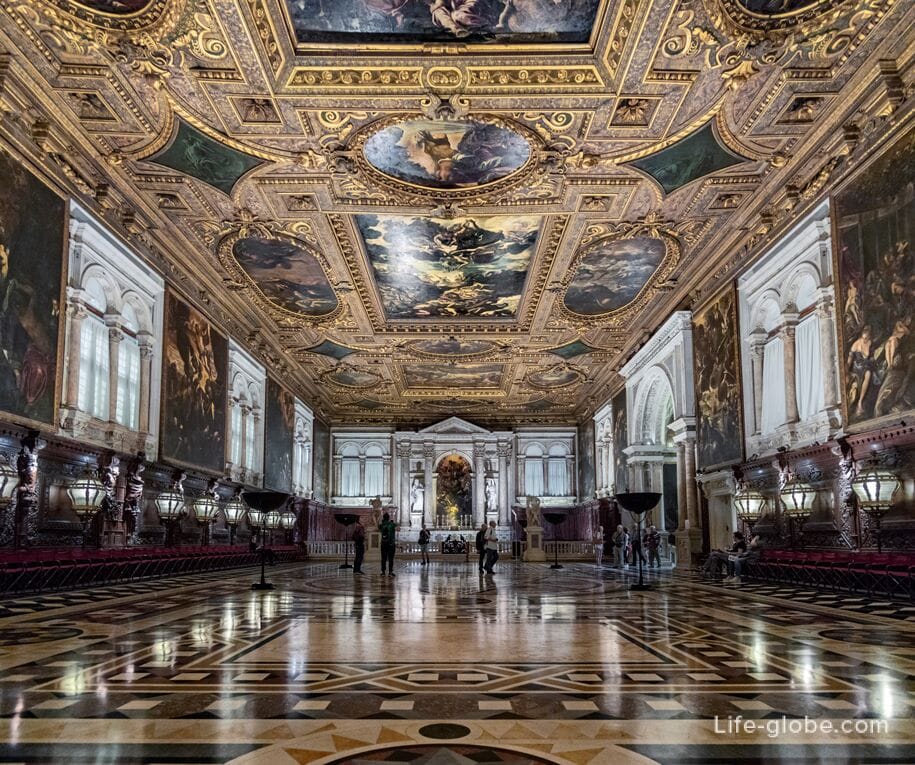
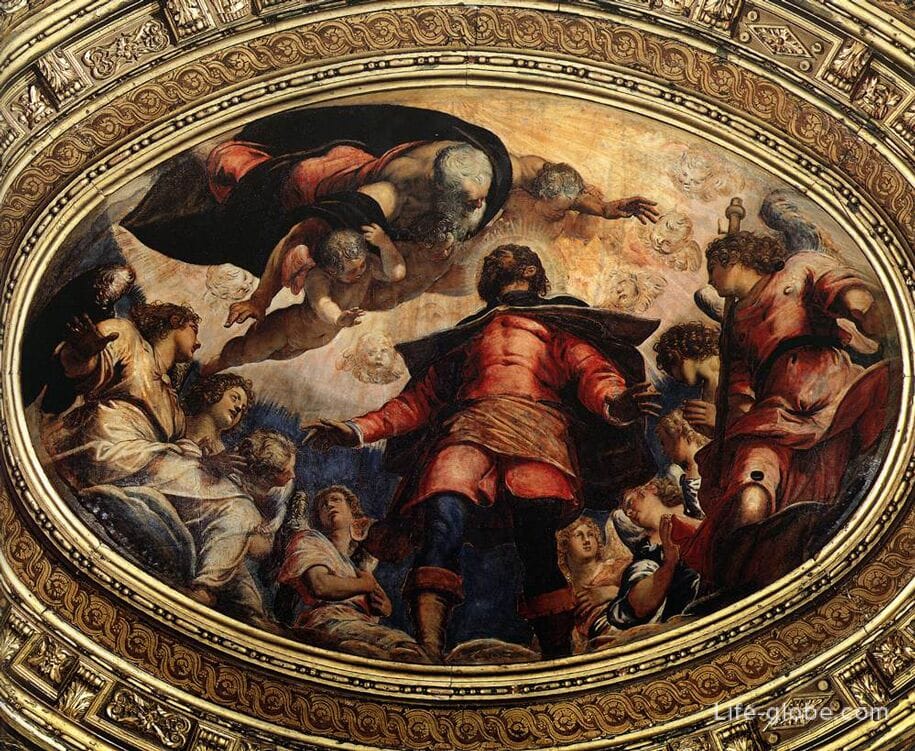
Church of San Rocco
In 1489, the school began the construction of its own church dedicated to San Rocco (Church of St. Roch, Chiesa di San Rocco), which was consecrated in 1508. The architect of the church is not exactly known, but it is traditionally attributed to Pietro Bon.
Between 1726-1732, the church was radically rebuilt according to the project of the Italian architect Giovanni Scalfarotto, who preserved only the old apses and the dome of the shrine. Between 1765 and 1769, the current facade was erected by the architect Bernardino Maccaruzzi.
The facade of the church has two levels and in decoration resembles the facade of the nearby skuola. From the original facade built by Bon, you can still see the old portal and the rosette window opening the side entrance.
In four niches on the facade there are statues of Venetian saints and blessed ones: in the lower register Gerardo Sagredo and Pietro Orseolo by the Italian sculptor and carver Giovanni Marchiori, in the upper register Lorenzo Giustiniani and Gregorio Barbarigo by the Italian sculptor Giovanni Maria Morlaiter. Between the two upper register statues is an impressive bas-relief depicting San Rocco healing plague victims by Morlighter. The facade is crowned by a statue of San Rocco surrounded by other statues of Venetian saints, Pietro Acotanto and Jacopo Salomonio. The upper casing of the door depicts San Rocco being carried to heaven by angels - this is a modern bronze copy of the original Marchiori, immured in the chapel of the right apse.
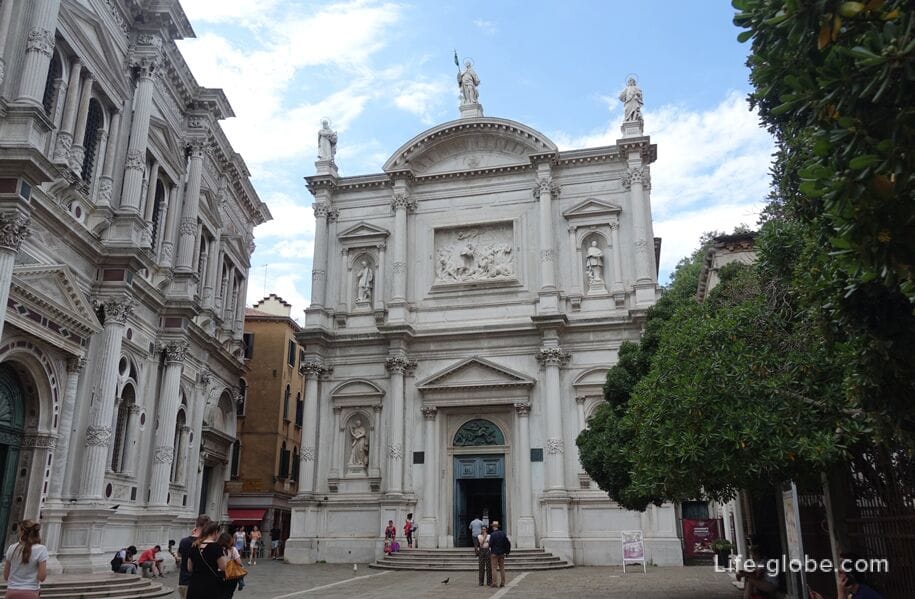
The church contains the relics of Saint Roch. The sarcophagus-reliquary of San Rocco is decorated on top with a statue by Giovanni Maria Mosca.
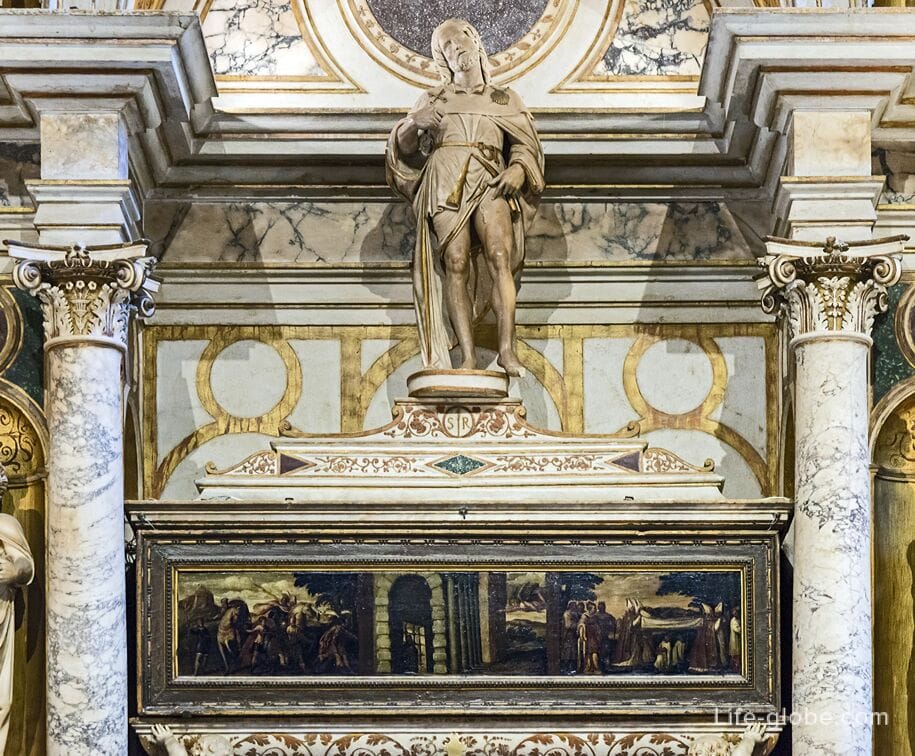
>
Also, the interior of the church of San Rocco stands out with statues of David and Santa Cecilia (1743) by Giovanni Marchiori, frescoes and paintings, including Tintoretto, the left chapel with the altar of the Blessed Sacrament and a wooden crucifix by sculptor Giuseppe Romanelli in 1950 and the right chapel with the original lunette of the main portal with Gloria di San Rocco works by Giovanni Marchiori.
The main altar of the church was designed by Venturino Fantoni (1517-1524) and decorated with statues by Italian sculptors Giovanni Maria Mosca and Bartolomeo Bergamasco.
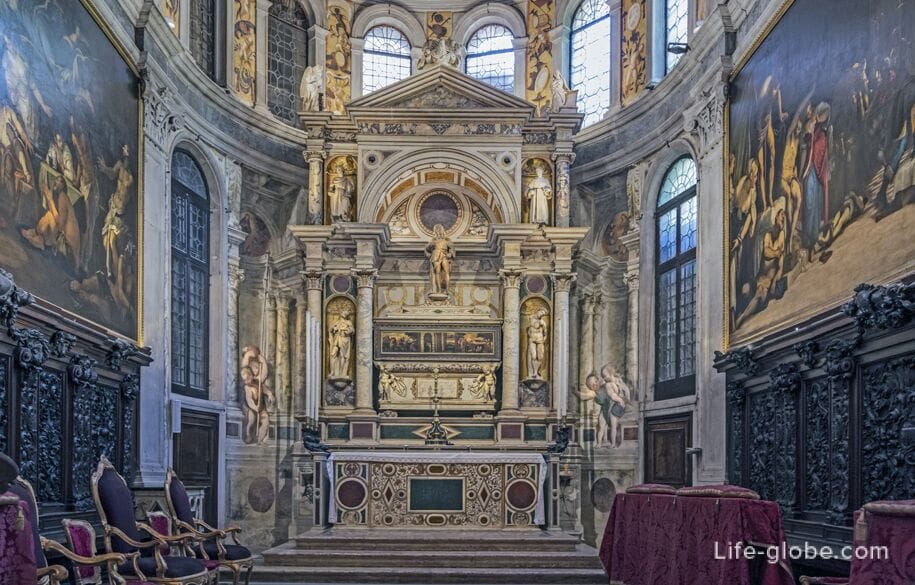
The organ of the organ builder of the Republic of Venice Pietro Nachini (1742), renovated in 1768 by the Italian master Gaetano Callido, with a choir decorated with wooden statues of Giovanni Marchiori, also attracts attention.
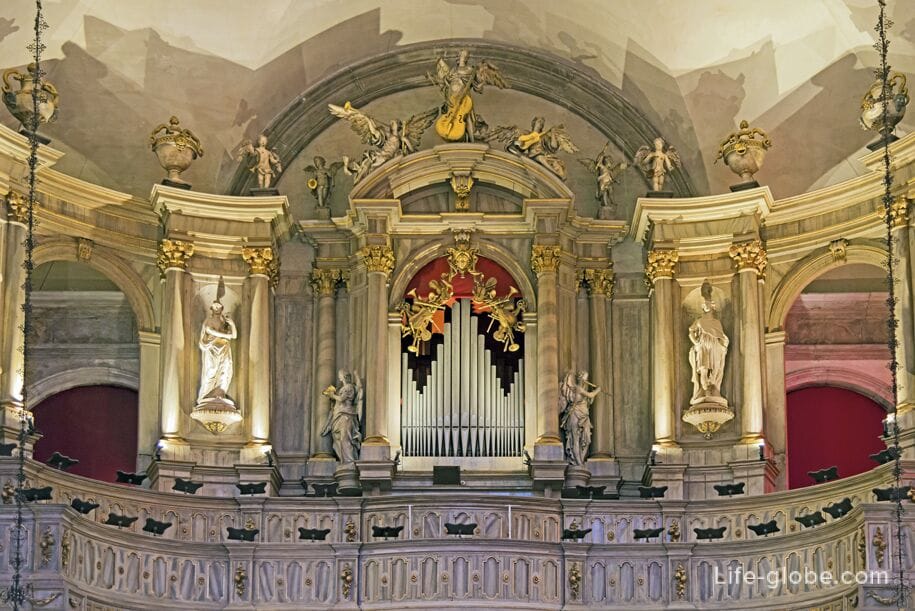
The dome of the church is painted with frescoes by Giuseppe Angeli.

Practical information
Visits to the Scuola of San Rocco and the Church of San Rocco are paid.
Information about the cost of entrance tickets, opening hours, etc., we recommend checking on the official website of the Great School of San Rocco: scuolagrandesanrocco.org.
Address of the San Rocco complex: Campo S. Rocco, 30125 Venezia VE, Italy.
All accommodation facilities in Venice, including in the historical center of the city and more remotely from it, can be viewed and booked here






